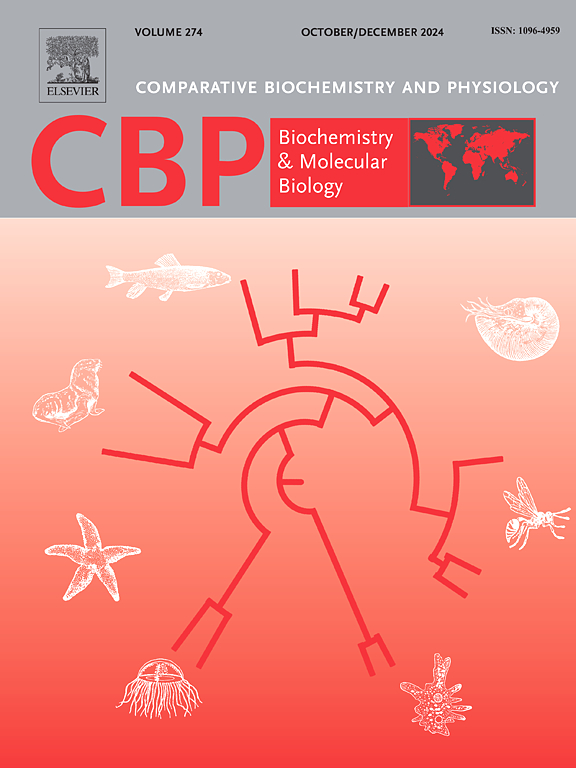Effects of dietary oregano essential oil on digestive tissue structure and function, antioxidant and immune responses and gut microbiota of red swamp crayfish (Procambarus clarkii)
IF 1.9
3区 生物学
Q4 BIOCHEMISTRY & MOLECULAR BIOLOGY
Comparative Biochemistry and Physiology B-Biochemistry & Molecular Biology
Pub Date : 2025-04-21
DOI:10.1016/j.cbpb.2025.111100
引用次数: 0
Abstract
Modifying the diet is an effective strategy to enhance the production and health of farmed red swamp crayfish (Procambarus clarkii). In this study the effects of adding dietary oregano essential oil (OEO) at 0, 100, 300, and 500 mg/kg concentrations were investigated in red swamp crayfish after a 3-week feeding trial. Histology showed no negative impacts on the structural integrity of the hepatopancreas and intestine. Total protease activity in the hepatopancreas, hemolymph alkaline and acid phosphatase activity, hemolymph superoxide dismutase activity and hepatopancreas glutathione levels were higher in the 500 mg/kg OEO group than in the 0 mg/kg group. No significant differences were observed in hepatopancreas phenoloxidase activity or hemolymph malondialdehyde content between treatment groups. Supplementing the diet with OEO upregulated the expression of antioxidant and immune-related genes in the hepatopancreas including metallothionein, gamma interferon-inducible lysosomal thiol reductase, and catalase in the 500 mg/kg OEO group relative to the 0 mg/kg control. Ferritin gene expression was unaltered. The intestinal microbiota of crayfish fed OEO showed an increased relative abundance of Proteobacteria and Actinobacteriota, and a lower abundance of Firmicutes. This study demonstrates the potential of OEO as a novel feed additive for enhancing antioxidant capacity and the immune response in red swamp crayfish. This research addresses the growing need for sustainable aquaculture practices and highlights the application of plant-derived bioactivities in improving crustacean health.

饲粮中添加牛至精油对克氏原螯虾消化组织结构和功能、抗氧化和免疫反应及肠道微生物群的影响
改变饲料是提高克氏原螯虾(Procambarus clarkii)产量和健康的有效策略。本试验通过3周的饲养试验,研究了在红沼泽小龙虾中添加0、100、300和500 mg/kg浓度的牛至精油(OEO)的效果。组织学显示对肝胰腺和肠的结构完整性没有负面影响。500 mg/kg OEO组肝胰脏总蛋白酶活性、血淋巴碱性和酸性磷酸酶活性、血淋巴超氧化物歧化酶活性和肝胰脏谷胱甘肽水平均高于0 mg/kg组。肝胰腺酚氧化酶活性和血淋巴丙二醛含量在治疗组间无显著差异。与0 mg/kg对照组相比,500 mg/kg OEO组肝胰腺中金属硫蛋白、γ干扰素诱导溶酶体硫醇还原酶和过氧化氢酶等抗氧化和免疫相关基因的表达上调。铁蛋白基因表达未见改变。小龙虾肠道菌群中变形菌门和放线菌门的相对丰度增加,厚壁菌门的相对丰度降低。本研究证明了OEO作为一种新型饲料添加剂在提高红沼泽小龙虾抗氧化能力和免疫应答方面的潜力。本研究解决了对可持续水产养殖实践日益增长的需求,并强调了植物源性生物活性在改善甲壳类动物健康方面的应用。
本文章由计算机程序翻译,如有差异,请以英文原文为准。
求助全文
约1分钟内获得全文
求助全文
来源期刊
CiteScore
4.60
自引率
4.50%
发文量
77
审稿时长
22 days
期刊介绍:
Comparative Biochemistry & Physiology (CBP) publishes papers in comparative, environmental and evolutionary physiology.
Part B: Biochemical and Molecular Biology (CBPB), focuses on biochemical physiology, primarily bioenergetics/energy metabolism, cell biology, cellular stress responses, enzymology, intermediary metabolism, macromolecular structure and function, gene regulation, evolutionary genetics. Most studies focus on biochemical or molecular analyses that have clear ramifications for physiological processes.

 求助内容:
求助内容: 应助结果提醒方式:
应助结果提醒方式:


